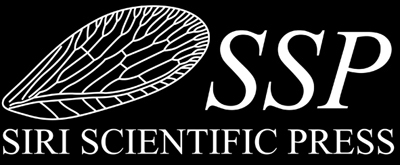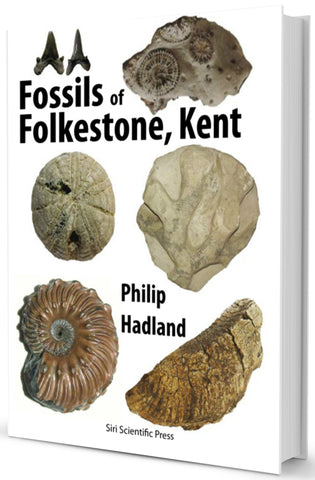new book review: Fossils of Folkestone, Kent
Posted by David Penney on
We are pleased to announce a nice new book review of our recent title: Fossils of Folkestone, Kent by Philip Hadland, which has just been published in Deposits Magazine, 2018 (Number 55, page 19 – snippets):
This guide has an advantage over others – this and others all have marvellous full colour illustrations of the relevant Gault fossils, but as anyone who has struggled over the boulders from the end of the concrete harbour to Copt Point will know, there is a lot of Greensand, containing marvellous and multitudinous trace fossils … and around the corner in East Wear Bay there is the beginning of the Chalk that ends up at the White Cliffs of Dover. The book includes lovely illustrations of the usual (and some of the less usual) suspects from the Gault (ammonites, crabs, belemnites, vertebrates and so on), but Philip Hadland also illustrates and discusses many of the fossils from the Lower Greensand, Chalk and Pleistocene sediments. The guide also covers the history of collecting at Folkestone, along with the geology, habitat reconstruction, etc. Importantly, it also contains brief information on preserving, cataloguing and storing fossils and a bibliography of references and further reading.
Click the cover to go to the product page for more information and order your copy
From the back cover
Folkestone is surely one of the top ten places to look for fossils in Britain. The variety of fossils that can be found there is truly staggering. For centuries geologists have visited Folkestone, mainly attracted by the beautiful Gault Clay ammonites that are so abundantly found along the beach. Aside from ammonites and other invertebrate fossils, a rich variety of vertebrates has been found, including rare dinosaur remains. There is no doubt an untapped potential for new and exciting discoveries at Folkestone.
This book aims to showcase the spectacular fossils that can be found at Folkestone in a series of 100 full colour plates (see below), illustrating approximately 200 different species from the Chalk, Gault Clay, Lower Greensand and also the Pleistocene mammal fauna. It is designed as a user-friendly identification guide for anyone collecting fossils there and hopefully will encourage more people to collect there and report any new rare finds.
List of plates
LOWER GREENSAND PLATE 1: Trace Fossils
LOWER GREENSAND PLATE 2: Trace Fossils
LOWER GREENSAND PLATE 3: Brachiopods
LOWER GREENSAND PLATE 4: Bivalves
LOWER GREENSAND PLATE 5: Gastropods
LOWER GREENSAND PLATE 6: Ammonites
LOWER GREENSAND PLATE 7: Ammonites
LOWER GREENSAND PLATE 8: Ammonites
LOWER GREENSAND PLATE 9: Barnacles
LOWER GREENSAND PLATE 10: Lobsters
LOWER GREENSAND PLATE 11: Echinoderms
LOWER GREENSAND PLATE 12: Fish
LOWER GREENSAND PLATE 13: Dinosaurs
GAULT PLATE 1: Trace Fossils
GAULT PLATE 2: Trace Fossils
GAULT PLATE 3: Corals
GAULT PLATE 4: Bryozoans
GAULT PLATE 5: Serpulids
GAULT PLATE 6: Brachiopods
GAULT PLATE 7: Bivalves
GAULT PLATE 8: Bivalves
GAULT PLATE 9: Gastropods
GAULT PLATE 10: Gastropods
GAULT PLATE 11: Gastropods
GAULT PLATE 12: Gastropods
GAULT PLATE 13: Scaphopods
GAULT PLATE 14: Nautiloids
GAULT PLATE 15: Belemnites
GAULT PLATE 16: Ammonites
GAULT PLATE 17: Ammonites
GAULT PLATE 18: Ammonites
GAULT PLATE 19: Ammonites
GAULT PLATE 20: Ammonites
GAULT PLATE 21: Ammonites
GAULT PLATE 22: Ammonites
GAULT PLATE 23: Ammonites
GAULT PLATE 24: Ammonites
GAULT PLATE 25: Ammonites
GAULT PLATE 26: Ammonites
GAULT PLATE 27: Ammonites
GAULT PLATE 28: Ammonites
GAULT PLATE 29: Ammonites
GAULT PLATE 30: Ammonites
GAULT PLATE 31: Ammonites
GAULT PLATE 32: Ammonites
GAULT PLATE 33: Ammonites
GAULT PLATE 34: Ammonites
GAULT PLATE 35: Ammonites
GAULT PLATE 36: Ammonites
GAULT PLATE 37: Ammonites
GAULT PLATE 38: Ammonites
GAULT PLATE 39: Ammonites
GAULT PLATE 40: Ammonites
GAULT PLATE 41: Ammonites
GAULT PLATE 42: Ammonites
GAULT PLATE 43: Ammonites
GAULT PLATE 44: Ammonites
GAULT PLATE 45: Crustaceans
GAULT PLATE 46: Lobsters
GAULT PLATE 47: Crabs
GAULT PLATE 48: Crabs
GAULT PLATE 49: Echinoderms
GAULT PLATE 50: Vertebrates – Sharks
GAULT PLATE 51: Vertebrates – Chimaeroids
GAULT PLATE 52: Vertebrates – Bony Fish
GAULT PLATE 53: Vertebrates – Bony Fish
GAULT PLATE 54: Vertebrates – Bony Fish
GAULT PLATE 55: Vertebrates – Bony Fish
GAULT PLATE 56: Vertebrates – Bony Fish
GAULT PLATE 57: Vertebrates – Reptiles
GAULT PLATE 58: Vertebrates – Reptiles
GAULT PLATE 59: Vertebrates – Reptiles
CHALK PLATE 1: Sponges
CHALK PLATE 2: Coral & Serpulid
CHALK PLATE 3: Brachiopods
CHALK PLATE 4: Bivalves
CHALK PLATE 5: Bivalves
CHALK PLATE 6: Bivalves
CHALK PLATE 7: Bivalves
CHALK PLATE 8: Gastropods
CHALK PLATE 9: Ammonites
CHALK PLATE 10: Ammonites
CHALK PLATE 11: Ammonites
CHALK PLATE 12: Ammonites
CHALK PLATE 13: Ammonites
CHALK PLATE 14: Crustaceans
CHALK PLATE 15: Echinoderms – Starfish
CHALK PLATE 16: Echinoderms – Sea Urchins
CHALK PLATE 17: Vertebrates – Fish
CHALK PLATE 18: Vertebrates – Fish
CHALK PLATE 19: Vertebrates – Fish
CHALK PLATE 20: Vertebrates – Fish
CHALK PLATE 21: Vertebrates – Reptiles
PLEISTOCENE MAMMALS PLATE 1 – Mammoth
PLEISTOCENE MAMMALS PLATE 2 – Woolly Rhino
PLEISTOCENE MAMMALS PLATE 3 – Woolly Rhino
PLEISTOCENE MAMMALS PLATE 4 – Red Deer
PLEISTOCENE MAMMALS PLATE 5 – Hippopotamus
PLEISTOCENE MAMMALS PLATE 6 – Hippopotamus
PLEISTOCENE MAMMALS PLATE 7 – Auroch
About the author
The author has been collecting fossils at Folkestone for around a decade and has been involved with curating various collections containing Folkestone specimens, including at Canterbury Museum, the Oxford University Museum of Natural History, and most recently he has been involved in establishing the new Folkestone Museum. The book includes a foreword by well-known palaeontologist Dean R. Lomax, author of Dinosaurs of the British Isles and Fossils of the Whitby Coast.
Share this post
- 0 comment
- Tags: Book review, News
0 comment

